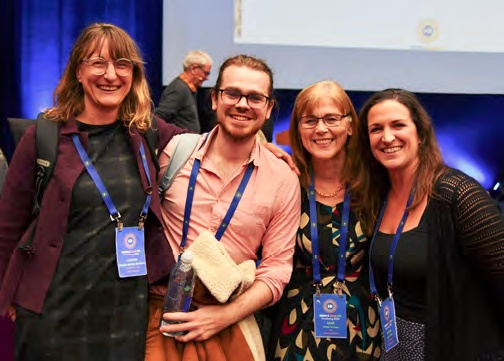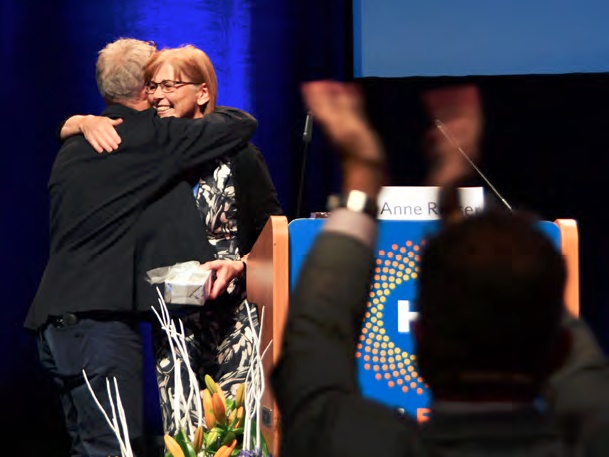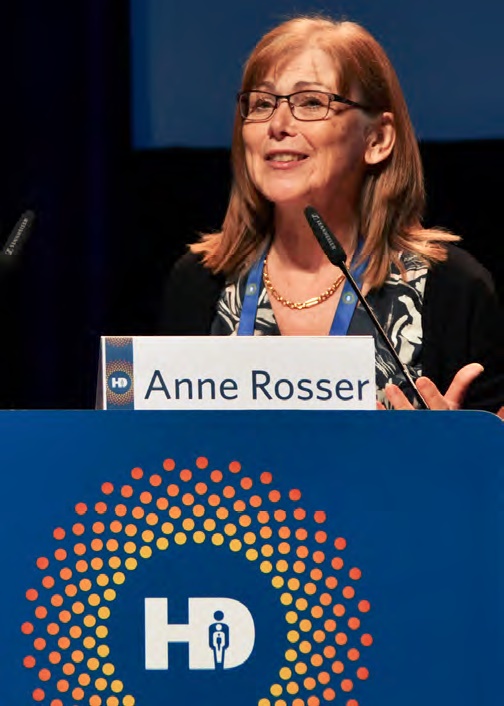Interview with Anne Rosser: A Driving Force in HD Research
Highlight from the: EHDN Newsletter_November2024_Issue53
Anne Rosser is Professor and Honorary Consultant in the Department of Neurology in the School of Medicine at Cardiff University, where she is the Director of the Cardiff University Brain Repair Group. In addition to her pioneering work on novel therapies for HD, she has undertaken critical roles within EHDN. Notably, Anne was the very first chair of the SBAC and held the position of EHDN Chair and Co-Chair from 2014 to 2024, from which she stepped down in Strasbourg this year.
How did you get involved in HD research?
I first got involved in HD back in 1994 – about a year after the gene was discovered. I had just started as an MRC Clinician Scientist Fellow in Cambridge, working on stem cell therapies for neurodegenerative diseases. John Hodges (famous behavioural neurologist and now retired) had recently set up a Huntington’s clinic and asked if I’d help out. We started a new clinic together, but as John’s main interest was understanding the underpinnings of neuropsychological deficits more broadly, he eventually stepped back a little, whereas the clinic became the mainstay of my work. I rapidly became increasingly interested in HD – and it’s been my key interest ever since.
What does it mean to be a ‘clinical scientist’ in the study of a rare disease like HD?
Basically, being a clinical scientist means undertaking research while also continuing clinical practice. The ways in which people do this vary hugely, including how they dedicate different proportions of their time to clinical work and research. This research could be anything from the basics of molecular and cellular research right through to very clinically orientated work, using human participants or working on a specific disease population, for example.
|
|
In my lab, the key theme is regenerative medicine, which means that we use stem cells, cell cultures, and animal studies. We think a lot about why a stem cell becomes a more specialist sort of cell (e.g., a brain cell). I’m particularly interested in how stem cells can become medium spiny neurons. Medium spiny neurons are a specific focus in understanding the pathophysiology of HD, given that they comprise 80-90% of neurons in the brain’s striatum, and that their degeneration results in deficits of movement, behaviour, and mood. |
I also direct some more clinically orientated research, where we focus on how we can take these emerging therapies through to clinical application. In collaborative work with Duncan McLauchlan, I’ve been looking at the behavioural aspects of HD, and I’ve supported Monica Busse in developing rehabilitation strategies for individuals with HD.
Cardiff University is a recognised leader in HD research. How did this come about?
Cardiff has a long history of involvement with HD. I moved to Cardiff in 2001, and by that time, Sir Peter Harper was already well known for his work in clinical genetics and for being part of the team involved in the discovery of the HD gene in 1993.
|
|
Peter had already made great strides in terms of the epidemiology of HD and had set up a clinic primarily focused on diagnosis (representing where the field was, in general, at that time). He had also done a lot of work raising awareness of HD in Wales, which I think we still see the benefits of to this day. Professor Leslie Jones was also already in Cardiff, and she had been working on various aspects of neurodegeneration, including Alzheimer’s disease, but her work gradually moved more towards HD. She was a great person to talk to and share ideas with. I took over Peter’s clinic and then developed it into a follow-up clinic, in line with how the field was shifting, and the focus differed as well because I was a neurologist rather than a geneticist. Then from that point, we developed clinical trials – including Enroll-HD. Sadly, Leslie unexpectedly passed away in 2022. As with Peter only the year before, we were struck by the profound significance of losing pioneering scientists who had devoted so much to the field.
Yet we remain resilient, and Cardiff continues to go from strength to strength. Over the last 20 years we’ve built up a critical mass of people working in the HD field. We have people working on the molecular basis of HD, like Tom Massey and Vincent Dion, and people working on stem cells, like Meng Li and Nick Allen. Mariah Lelos (my close collaborator) is focused on behavioural and animal models, while Duncan McLauchlan and Cheney Drew work more on the clinical side. We are also lucky to have our colleagues, Peter Holmans, a statistician, and Liam Gray who is a neurosurgeon with an interest in HD.
Cardiff University Brain Imaging Centre possesses really cutting-edge imaging hardware and we’ve got people like Derek Jones and Claudia Metzler-Baddeley who work on brain imaging and cognitive rehabilitation. And finally, in May this year, we launched the HD Centre in Wales to bring together all this expertise!
We were all thrilled to see so many faces, familiar and new, at EHDN & Enroll-HD 2024. What stands out for you about these bi-annual meetings?
I always think the HD community is really special – it stands out across different research fields as being very collaborative and supportive. It’s amazing to see all these people from across Europe who you’ve been working alongside for several decades and, at the same time, all these energetic young people who are just coming into the field.
 |
The interdisciplinary aspect is also critical. We can hear all about cutting edge molecular genetics, clinical trials and care, and meet up with the HD-affected families, all within the same meeting. There is a real sense that we are working together towards a common set of aims.
At the Strasbourg meeting, a key theme was ‘20 years of EHDN’. What did that mean for you?
A lot has changed over the last 20 years. I spent some time recently looking back at some of the programmes from the early conference – around 2005 – and at that point, we knew relatively little about the trajectory of HD, never mind having any realistic possibility of treatment. But now we have clinical trials that offer the potential for meaningful treatment – and that is absolutely amazing. It’s incredible to see how the HD field has developed over the years and to have the prospect of meaningful treatments possibly within our grasp.
Of course, at EHDN, we will also have to continue evolving. I think it has been a hugely important entity and has genuinely brought people together across Europe (and beyond). I’m personally very grateful because EHDN has resulted in me having amazing col-leagues across Germany, France, Spain, and further afield – who I almost certainly would not have come across otherwise. EHDN now has influence globally and has opened up many new and exciting collaborations.
We know that the search for treatments for HD will continue, and most likely, we will need to look at the role of personalised medicine in HD in due course. But without doubt, for EHDN and for the HD field, there are many exciting things on the horizon.
 |
| ‘I always think the HD community is really special – it stands out across different research fields as being very collaborative and supportive.’ Anne Rosser |



